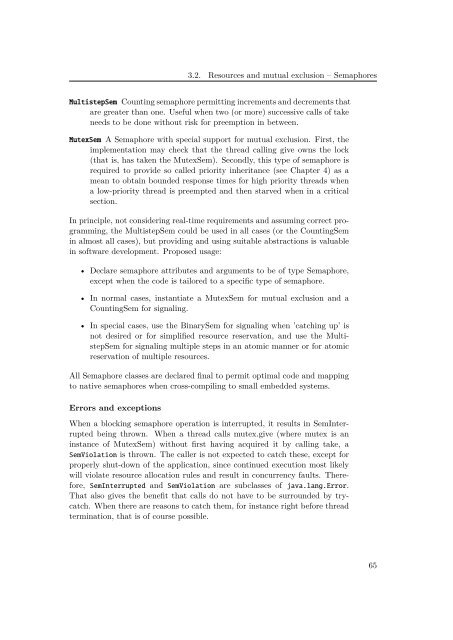JAVA-BASED REAL-TIME PROGRAMMING
JAVA-BASED REAL-TIME PROGRAMMING
JAVA-BASED REAL-TIME PROGRAMMING
Create successful ePaper yourself
Turn your PDF publications into a flip-book with our unique Google optimized e-Paper software.
3.2. Resources and mutual exclusion – Semaphores<br />
MultistepSem Counting semaphore permitting increments and decrements that<br />
are greater than one. Useful when two (or more) successive calls of take<br />
needs to be done without risk for preemption in between.<br />
MutexSem A Semaphore with special support for mutual exclusion. First, the<br />
implementation may check that the thread calling give owns the lock<br />
(that is, has taken the MutexSem). Secondly, this type of semaphore is<br />
required to provide so called priority inheritance (see Chapter 4) as a<br />
mean to obtain bounded response times for high priority threads when<br />
a low-priority thread is preempted and then starved when in a critical<br />
section.<br />
In principle, not considering real-time requirements and assuming correct programming,<br />
the MultistepSem could be used in all cases (or the CountingSem<br />
in almost all cases), but providing and using suitable abstractions is valuable<br />
in software development. Proposed usage:<br />
• Declare semaphore attributes and arguments to be of type Semaphore,<br />
except when the code is tailored to a specific type of semaphore.<br />
• In normal cases, instantiate a MutexSem for mutual exclusion and a<br />
CountingSem for signaling.<br />
• In special cases, use the BinarySem for signaling when ’catching up’ is<br />
not desired or for simplified resource reservation, and use the MultistepSem<br />
for signaling multiple steps in an atomic manner or for atomic<br />
reservation of multiple resources.<br />
All Semaphore classes are declared final to permit optimal code and mapping<br />
to native semaphores when cross-compiling to small embedded systems.<br />
Errors and exceptions<br />
When a blocking semaphore operation is interrupted, it results in SemInterrupted<br />
being thrown. When a thread calls mutex.give (where mutex is an<br />
instance of MutexSem) without first having acquired it by calling take, a<br />
SemViolation is thrown. The caller is not expected to catch these, except for<br />
properly shut-down of the application, since continued execution most likely<br />
will violate resource allocation rules and result in concurrency faults. Therefore,<br />
SemInterrupted and SemViolation are subclasses of java.lang.Error.<br />
That also gives the benefit that calls do not have to be surrounded by trycatch.<br />
When there are reasons to catch them, for instance right before thread<br />
termination, that is of course possible.<br />
65

















